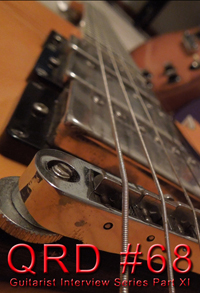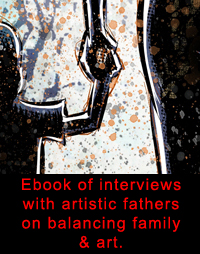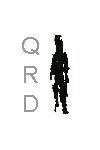
August 2014

Name: Marcus Skinner
Bands: Bird Traps
Websites: www.birdtraps.co, www.birdtraps.bandcamp.com
QRD – What was your first guitar & what happened to it?
Marcus – My first chops were learnt as a young teenager on a cheap nylon string acoustic with terrible action & a no-name white bass guitar I bought in a pawn shop, they were both bought around the same time & didn’t last long. My first decent guitar was about 4 years later, a black 1972 Fender Mustang which I bought here in Melbourne, which is still in my collection.
QRD – What’s your typical set-up from guitar to effects to amplifier?
Marcus – The guitar setup for the Bird Traps album The Colour Fields was designed specifically for the album. I used my 1970s Greco SA550 semi-acoustic through a volume/buffer, compressor, homemade fuzz clone, distortion, looper, delay, & reverb into my 1970s Fender silver-face Vibrolux.
QRD – What’s the most important part of your rig - guitar, amplifier, or effects?
Marcus – Guitar, effects, then amp.
QRD – What’s your main amplifier & why?
Marcus – I’ve owned my 1970’s Fender silver-face Vibrolux for about 12 years now & at the moment it’s all I have. It’s loud, relatively clean, & a classic.
QRD – What’s your main guitar & what are the features that make it such?
Marcus – At the moment, my go-to instruments are a vintage 1970s Greco SA550 semi-acoustic purchased in Japan a few years ago & a 1970s Rickenbacker 4001 bass, & they both sit in my studio close at hand (the rest sit in cases). The Greco law-suit-era guitars are a favourite of mine, they were built between the early 70s & mid 80s in the FujiGen factory in Japan & were copies of mostly Fender, Rickenbacker, & Gibson designs.
QRD – If you had a signature pedal, what would it be & what would some of its features be?
Marcus – I have around 16 pedals in my collection - mostly vintage fuzz pedals like Electro Harmonix Little Muff, various Big Muffs, Morley Fuzz-Wah, Japanese BOSS, Pro Co Rats, & a few modern effects from TC Electronics & Strymon - who both are doing some great designs & powered by Cioks. A few years ago, I built my first clone of an early Electro Harmonix Big Muff Triangle & a year later a Tychobrahe fuzz clone which both get used quite a bit. So, I reckon my signature pedal would be a kind of multi-effect of two delays, two dirty fuzzes & reverb, all in one. Delays designed around the Empress Vintage Superdelay & a fuzz based around the Electro Harmonix Big Muff Civil-War or Rams Head era, & on top of that a voltage sag & stereo out would be good to.
QRD – How many guitars do you own?
Marcus – I have five guitars, mostly vintage 70s. A Greco SA550 semi acoustic, Greco Super Sound Precision bass, Fender Mustang, Fender VI baritone, Yamaha FG251 acoustic, & a black Rickenbacker 4001.
QRD – What do you wish guitar cases had that they usually don’t?
Marcus – A guitar tech & a security guard, all inside an airline-customs-proof-hardcase
QRD – Do you upgrade & customize your guitars or just stick with what you get?
Marcus – I try to keep my guitars true to what they are.
QRD – How thoroughly do you research or test a piece of equipment before buying it?
Marcus – These days I usually start with online research, maybe talk to friends, but where possible testing it out always helps.
QRD – Are you after one particular guitar tone & locking into it, or do you like to change your tone around a lot?
Marcus – It does change depending what I’m working on. The Colour Fields was partly composed on guitar of built up chords, harmonies, long tones, & no attack. So I start with lots of delay & reverb & then play around with various add-ons like bows, ebows, fuzz, & different guitars & extra pedals.
QRD – What are some guitars, amps, & pedals you particularly lust after?
Marcus – There are a lot of new builders putting out quality gear like Strymon, TC Electronics, Tyms Guitars, & the new line of Supro amplifiers look really interesting. Vintage gear is different, I usually look at older guitars, stringed instruments, & classic fuzz pedals. My last purchase was an old half-size Hofner cello via ebay.
QRD – Do you see your guitar as your ally or adversary in making music?
Marcus – All stringed instruments are a major tool in creating my music & the guitar would be at the forefront.
QRD – Who are the guitarists that most influenced your playing & sound?
Marcus – When I was young, it was guitar-based rock music & innovators who used their instruments to create something unique who influenced me to play, like Thurston Moore, Glenn Branca & Kevin Shields. After some digging, I discovered a wider world of guitarists such as Derek Bailey, Oren Ambarchi, Keiji Haino, Loren Connors, John Fahey, & Mick Turner for example, all have a unique take on tone & technique.
QRD – What’s the most physical damage you’ve done to a guitar & how did you do it?
Marcus – I’ve thrown my Fender Mustang around on stage & had an open cut on my finger bleed a few weeks in a row on a Vox guitar during a European tour. But no broken necks or major issues.
QRD – What gauge strings do you use & why?
Marcus – I went through a stage of using slightly heavier gauge strings. When I filled the void with a 1980s Fender baritone VI, I went back to typical gauges. Now I have a good choice between acoustic, semi-acoustic, solid, baritone, & bass.
QRD – What tunings do you use & why?
Marcus – I think all my guitars are in standard tuning at the moment. Although I’ll sometimes use drop-D & Ostrich tuning (which is six strings tuned to the one pitch - usually D) or tuning to a particular chord per song. Listening & reading up on Glenn Branca, Sonic Youth, & Velvet Underground as a teenager turned me on to the concept of detuning & using the guitar as a wall of sound.
QRD – Do you prefer tablature, sheet music, or some other notation system for writing down your own ideas?
Marcus – I started writing a type of notation/scrawl just for myself; although I still prefer a basic notation, memory, & recording demos. If I’m dealing with string players or more complex music - I’ll write out basic scores.
QRD – How high do you hold your guitar when playing (strap length)?
Marcus – Nice & low.
QRD – What’s your favorite guitar gadget (Ebow, capo, slide, string cutter, etc)?
Marcus – I have a bunch of useful tools, various viola & cello bows which get quite a bit of use, also extras like capos, heavy screwdrivers, ebows, metal, & glass slides.
QRD – What’s a guitar technique you’d like to master, but haven’t?
Marcus – Early American blues, ragas, &/or classical.
QRD – What would you teach someone in a guitar lesson that you don’t think they would generally get from a guitar teacher?
Marcus – Don’t rush into learning the covers, consider guitar playing more as an artform.
QRD – What’s your take on tremolo/vibrato systems?
Marcus – I use the tremolo arm on my Fender VI quite a lot.
QRD – What do you see as the difference between lead guitar & rhythm guitar players?
Marcus – I prefer to hear guitarists who play somewhere in-between, a mix of lead & rhythm.
QRD – Who do you think is currently the most innovative guitar player & why?
Marcus – I couldn’t break it down to just one. There are plenty of impressive guitarists/bassists out there currently playing, like Keiji Haino, Thurston Moore, Kevin Shields, Mick Turner, Blixa Bargeld, Al Cisneros, Glenn Branca, Stephen O’Malley, Chris Smith, & Oren Ambarchi are all producing amazing work with unique techniques. Also the recordings of Derek Bailey, John Fahey, & Skip James are continuing to influence to me. The list goes on.
Bands: Bird Traps
Websites: www.birdtraps.co, www.birdtraps.bandcamp.com
QRD – What was your first guitar & what happened to it?
Marcus – My first chops were learnt as a young teenager on a cheap nylon string acoustic with terrible action & a no-name white bass guitar I bought in a pawn shop, they were both bought around the same time & didn’t last long. My first decent guitar was about 4 years later, a black 1972 Fender Mustang which I bought here in Melbourne, which is still in my collection.
QRD – What’s your typical set-up from guitar to effects to amplifier?
Marcus – The guitar setup for the Bird Traps album The Colour Fields was designed specifically for the album. I used my 1970s Greco SA550 semi-acoustic through a volume/buffer, compressor, homemade fuzz clone, distortion, looper, delay, & reverb into my 1970s Fender silver-face Vibrolux.
QRD – What’s the most important part of your rig - guitar, amplifier, or effects?
Marcus – Guitar, effects, then amp.
QRD – What’s your main amplifier & why?
Marcus – I’ve owned my 1970’s Fender silver-face Vibrolux for about 12 years now & at the moment it’s all I have. It’s loud, relatively clean, & a classic.
QRD – What’s your main guitar & what are the features that make it such?
Marcus – At the moment, my go-to instruments are a vintage 1970s Greco SA550 semi-acoustic purchased in Japan a few years ago & a 1970s Rickenbacker 4001 bass, & they both sit in my studio close at hand (the rest sit in cases). The Greco law-suit-era guitars are a favourite of mine, they were built between the early 70s & mid 80s in the FujiGen factory in Japan & were copies of mostly Fender, Rickenbacker, & Gibson designs.
QRD – If you had a signature pedal, what would it be & what would some of its features be?
Marcus – I have around 16 pedals in my collection - mostly vintage fuzz pedals like Electro Harmonix Little Muff, various Big Muffs, Morley Fuzz-Wah, Japanese BOSS, Pro Co Rats, & a few modern effects from TC Electronics & Strymon - who both are doing some great designs & powered by Cioks. A few years ago, I built my first clone of an early Electro Harmonix Big Muff Triangle & a year later a Tychobrahe fuzz clone which both get used quite a bit. So, I reckon my signature pedal would be a kind of multi-effect of two delays, two dirty fuzzes & reverb, all in one. Delays designed around the Empress Vintage Superdelay & a fuzz based around the Electro Harmonix Big Muff Civil-War or Rams Head era, & on top of that a voltage sag & stereo out would be good to.
QRD – How many guitars do you own?
Marcus – I have five guitars, mostly vintage 70s. A Greco SA550 semi acoustic, Greco Super Sound Precision bass, Fender Mustang, Fender VI baritone, Yamaha FG251 acoustic, & a black Rickenbacker 4001.
QRD – What do you wish guitar cases had that they usually don’t?
Marcus – A guitar tech & a security guard, all inside an airline-customs-proof-hardcase
QRD – Do you upgrade & customize your guitars or just stick with what you get?
Marcus – I try to keep my guitars true to what they are.
QRD – How thoroughly do you research or test a piece of equipment before buying it?
Marcus – These days I usually start with online research, maybe talk to friends, but where possible testing it out always helps.
QRD – Are you after one particular guitar tone & locking into it, or do you like to change your tone around a lot?
Marcus – It does change depending what I’m working on. The Colour Fields was partly composed on guitar of built up chords, harmonies, long tones, & no attack. So I start with lots of delay & reverb & then play around with various add-ons like bows, ebows, fuzz, & different guitars & extra pedals.
QRD – What are some guitars, amps, & pedals you particularly lust after?
Marcus – There are a lot of new builders putting out quality gear like Strymon, TC Electronics, Tyms Guitars, & the new line of Supro amplifiers look really interesting. Vintage gear is different, I usually look at older guitars, stringed instruments, & classic fuzz pedals. My last purchase was an old half-size Hofner cello via ebay.
QRD – Do you see your guitar as your ally or adversary in making music?
Marcus – All stringed instruments are a major tool in creating my music & the guitar would be at the forefront.
QRD – Who are the guitarists that most influenced your playing & sound?
Marcus – When I was young, it was guitar-based rock music & innovators who used their instruments to create something unique who influenced me to play, like Thurston Moore, Glenn Branca & Kevin Shields. After some digging, I discovered a wider world of guitarists such as Derek Bailey, Oren Ambarchi, Keiji Haino, Loren Connors, John Fahey, & Mick Turner for example, all have a unique take on tone & technique.
QRD – What’s the most physical damage you’ve done to a guitar & how did you do it?
Marcus – I’ve thrown my Fender Mustang around on stage & had an open cut on my finger bleed a few weeks in a row on a Vox guitar during a European tour. But no broken necks or major issues.
QRD – What gauge strings do you use & why?
Marcus – I went through a stage of using slightly heavier gauge strings. When I filled the void with a 1980s Fender baritone VI, I went back to typical gauges. Now I have a good choice between acoustic, semi-acoustic, solid, baritone, & bass.
QRD – What tunings do you use & why?
Marcus – I think all my guitars are in standard tuning at the moment. Although I’ll sometimes use drop-D & Ostrich tuning (which is six strings tuned to the one pitch - usually D) or tuning to a particular chord per song. Listening & reading up on Glenn Branca, Sonic Youth, & Velvet Underground as a teenager turned me on to the concept of detuning & using the guitar as a wall of sound.
QRD – Do you prefer tablature, sheet music, or some other notation system for writing down your own ideas?
Marcus – I started writing a type of notation/scrawl just for myself; although I still prefer a basic notation, memory, & recording demos. If I’m dealing with string players or more complex music - I’ll write out basic scores.
QRD – How high do you hold your guitar when playing (strap length)?
Marcus – Nice & low.
QRD – What’s your favorite guitar gadget (Ebow, capo, slide, string cutter, etc)?
Marcus – I have a bunch of useful tools, various viola & cello bows which get quite a bit of use, also extras like capos, heavy screwdrivers, ebows, metal, & glass slides.
QRD – What’s a guitar technique you’d like to master, but haven’t?
Marcus – Early American blues, ragas, &/or classical.
QRD – What would you teach someone in a guitar lesson that you don’t think they would generally get from a guitar teacher?
Marcus – Don’t rush into learning the covers, consider guitar playing more as an artform.
QRD – What’s your take on tremolo/vibrato systems?
Marcus – I use the tremolo arm on my Fender VI quite a lot.
QRD – What do you see as the difference between lead guitar & rhythm guitar players?
Marcus – I prefer to hear guitarists who play somewhere in-between, a mix of lead & rhythm.
QRD – Who do you think is currently the most innovative guitar player & why?
Marcus – I couldn’t break it down to just one. There are plenty of impressive guitarists/bassists out there currently playing, like Keiji Haino, Thurston Moore, Kevin Shields, Mick Turner, Blixa Bargeld, Al Cisneros, Glenn Branca, Stephen O’Malley, Chris Smith, & Oren Ambarchi are all producing amazing work with unique techniques. Also the recordings of Derek Bailey, John Fahey, & Skip James are continuing to influence to me. The list goes on.








